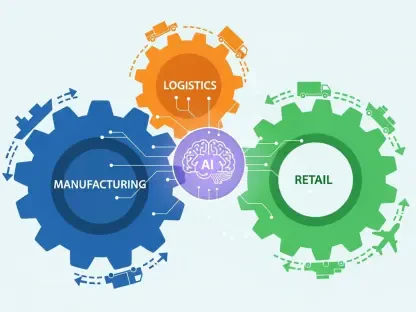The rapid integration of artificial intelligence tools into supply chain operations has transformed how businesses manage logistics, forecasting, and inventory, promising unprecedented efficiency and insight. However, as companies race to adopt platforms like ChatGPT, Gemini, and Copilot to streamline processes, a critical question looms over this technological leap: are these innovations opening new doors to cybersecurity threats? Recent studies reveal a troubling gap between the enthusiasm for AI adoption and the readiness to address associated risks. With a significant portion of users lacking proper training on security and privacy concerns, sensitive data is often shared without oversight, exposing supply chains to potential breaches. This growing reliance on AI, while beneficial, appears to outpace the development of robust safeguards, creating vulnerabilities that cybercriminals are quick to exploit. The intersection of innovation and risk demands a closer examination of how these tools impact the security of interconnected supply networks.
The Surge of AI Adoption and Emerging Vulnerabilities
The adoption of AI tools in supply chains has seen a remarkable increase, with usage climbing to 65% among surveyed professionals in recent data, reflecting a 21% year-over-year growth. Platforms such as ChatGPT, with a 77% adoption rate, lead the charge, followed by Gemini at 49% and Copilot at 26%. These tools are embedded in everything from demand prediction to vendor communication, revolutionizing operational efficiency. Yet, this swift integration comes with a significant downside: a staggering 58% of users have received no formal training on the security or privacy implications of these technologies. Without proper education, employees often unknowingly expose critical supply chain data, making systems ripe for exploitation. The lack of awareness is not just a minor oversight; it creates a systemic vulnerability that extends across global networks where a single breach can disrupt entire ecosystems of trade and distribution.
Compounding this issue is the risky behavior observed among users, with 43% admitting to sharing sensitive workplace information through AI platforms without employer consent. This includes internal documents, financial records, and client details—data that, if compromised, could cripple supply chain integrity. Such practices are particularly alarming in an era where cybercrime is on the rise, with 44% of respondents reporting losses due to scams like phishing and identity theft, up 9% from previous figures. The intersection of untrained users and sophisticated cyber threats forms a perfect storm, especially in supply chains where data flows across multiple stakeholders. Younger generations, such as Gen Z and Millennials, who are deeply immersed in digital tools, appear to be disproportionately affected, highlighting a generational divide in both exposure and preparedness for these risks.
Gaps in Cybersecurity Training and Practices
Despite the clear dangers, cybersecurity training remains woefully inadequate for many in the supply chain sector. Over 55% of surveyed individuals lack access to any form of security education, and even among those who do, only 32% actively engage with it. When utilized, training proves effective, boosting phishing recognition in 47% of participants and encouraging multi-factor authentication adoption in 42%. However, barriers such as time constraints and doubts about training relevance deter widespread participation. This reluctance to prioritize security education is a critical misstep in an environment where AI tools are becoming indispensable. Supply chain managers and employees need tailored, engaging programs that demonstrate tangible benefits, rather than generic modules that fail to address the specific risks posed by AI integration in their workflows.
Beyond training, fundamental security habits are also lacking, further exposing supply chains to threats. Only 62% of respondents consistently use unique passwords, a decline from prior trends, while 41% avoid password managers altogether. Although 77% recognize the importance of multi-factor authentication, a mere 41% implement it regularly. Software updates and data backups fare slightly better, with 56% and 47% adherence respectively, but these figures still indicate significant gaps. Confidence in identifying malicious emails or links stands at 66%, yet fewer than half report phishing attempts, limiting collective defense mechanisms. These inconsistencies in basic practices underscore a broader challenge: even as AI tools enhance supply chain operations, the human element remains a weak link that cybercriminals can exploit with increasing sophistication.
Rising Concerns Over AI-Driven Cybercrime
A pervasive anxiety surrounds the potential for AI to amplify cybercrime within supply chains, with 63% of surveyed individuals expressing concern about AI facilitating impersonation and scam evasion. An alarming 65% believe AI enables criminals to mimic trusted entities, while 67% fear it blurs the lines between authentic and fabricated information. Additionally, 54% anticipate that AI will make scams harder to detect, a worry compounded by the technology’s ability to generate convincing fakes. These concerns are not unfounded, as supply chains rely heavily on trust and verification across vendors and partners. A single AI-generated deception could trigger cascading failures, from delayed shipments to financial losses, emphasizing the dual nature of AI as both a productivity enhancer and a potential threat vector in critical operations.
The implications of AI-driven cybercrime extend beyond immediate security risks, with 44% of respondents foreseeing employment shifts due to AI integration in supply chains. This reflects a broader unease about how these tools reshape roles and responsibilities, often without clear policies to mitigate associated dangers. The fear of undetectable scams and data breaches is particularly acute in industries where real-time decision-making depends on accurate information. As AI continues to evolve, the sophistication of cyber threats will likely grow, making it imperative for supply chain stakeholders to anticipate and counteract these risks. The collective recognition of AI’s potential to both innovate and endanger highlights the urgent need for proactive measures to secure digital infrastructures against emerging threats.
Building a Secure Future for AI in Supply Chains
Looking back, the unchecked adoption of AI tools in supply chains revealed a stark disconnect between technological advancement and cybersecurity readiness. The surge in usage, coupled with inadequate training for 58% of users and widespread risky data-sharing habits, painted a landscape of vulnerability that cybercriminals readily exploited. Reflecting on the data, the rise in cybercrime victimization to 44% and persistent gaps in basic security practices underscored how innovation often outpaced preparation. The pervasive concern about AI enabling scams and impersonation further highlighted a critical tension between efficiency gains and emerging risks. Moving forward, supply chain leaders must prioritize comprehensive training programs tailored to AI-specific threats, alongside enforcing robust security protocols. Investing in engaging education, promoting consistent habits like multi-factor authentication, and fostering a culture of vigilance can help mitigate dangers. As the digital landscape evolves, collaboration among organizations, policymakers, and educators will be essential to safeguard interconnected networks against the next wave of cyber threats.









